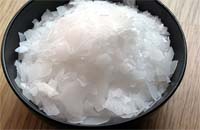Difference Between Sodium and Salt

When you say salt, you normally refer to table salt. Actually, salt is sodium chloride (NaCl), and it has been a big part of human existence. Archeological evidence suggests that salt has been extracted for over 8000 years. It even became a very valuable commodity, and also became a major part of various religious and cultural traditions.
Salt has, in fact, become one of the basic tastes ‘“ that taste is termed as ‘salty’. There are different kinds of salts for human consumption, such as sea salt, refined salt, and iodized salt. Nowadays, people often use the term ‘salt’ as interchangeable with ‘sodium’. This is primarily due to salt’s chemical composition, but remarkably, salt, which is sodium chloride, is only 40 percent sodium. The majority (60 percent) is chloride. In spite of this, salt is often associated more closely with sodium.
Sodium is a mineral or a metallic element, and symbolized by Na. It is considered as an essential nutrient, but like all things, too much sodium can be bad for you. Many people think of sodium to be coming mostly from salt, but in reality, sodium is practically everywhere. With salt or without salt, food items we consume may still have lots of sodium. Processed foods, sea foods, frozen and canned goods – all of them contain sodium, which is more than enough for our dietary allowance. Overconsumption of sodium can be very bad for our health, as it can lead to hypertension and other cardiovascular diseases.
When people are cutting back on salt in their diets, what they really mean is that they are concerned with their sodium intake, because it is the sodium that kills, and not the salt. It should be mentioned, that even when people avoid consuming salt, they may still get a lot of sodium from other sources. So in effect, staying away from salt is NOT the only solution.
The recommended amount of consumption for sodium per day is 2,400 mg. Such a recommendation is for average healthy adults, because people with predisposed tendencies towards cardiovascular diseases should consume less. That 2,400 mg of sodium can be found in one teaspoon of salt. This means, at least in theory, that an average healthy individual needs to consume about one teaspoon of salt daily to fill their dietary allowance. However, it is not that easy, because sodium is also present in other food items, and it is essentially sodium that you should be avoiding.
Nevertheless, sodium is still vital in our bodies. It helps proper distribution of water in our bodies, and aids in the maintenance of fluid volume in the cells and tissues. It is also concerned with our muscular and neurological functions. However, sodium is adequately obtained from today’s food, and maybe, people are right to cut back on salt to prevent the overconsumption of sodium.
Summary:
1. Salt is sodium chloride (NaCL), a chemical compound made of 40 percent sodium and 60 percent chloride.
2. Sodium is a metallic element.
3. It is actually the overconsumption of sodium that causes health problems. Sodium can be found in other sources, and not in salt alone.
4. One teaspoon of salt has 2,400 mg of sodium.
5. Sodium is practically in every food item.
- Difference Between Lymphoma and Leukemia - March 7, 2024
- Difference Between CP and CPK - June 8, 2010
- Difference Between PPTP and L2TP - June 7, 2010

Tell Mayor Bloomberg to stop his initiative to reduce sodium and to leave health decisions to doctors and patients and food decisions to individuals.
Send the message:
No more public health policies based on a false premise.
No more nanny state alarmism and control.
No more experimenting with our lives.
Sign the petition at MyFoodMyChoice.org
This is plain crazy.
2,400 mg of Na (sodium) equals 2.4 kilograms
Somebody needs to get their arithmetic straight
There is no “recommended amount of consumption for sodium”. Just thought I’d point that out. The DV (daily value) suggests that we consume LESS THAN 2300 mg of sodium per day, but there is no minimum amount of sodium that we need per day, as there is more than enough to balance our electrolytes with regular healthy foods which do not have added sodium chloride.